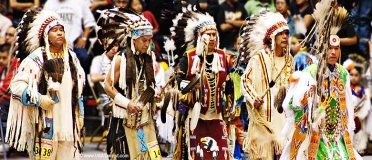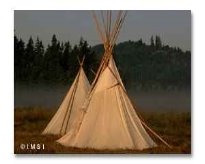The American Indians
Lesson
The American Indians
Мета: розвивати творчі здібності учнів, практикувати їх в умінні ставити незаплановані запитання, що ви-никають під час бесіди, вчити аргументовано відстоювати власну думку, мислити англійською мовою, розвивати навички самостійної роботи, виховувати почуття поваги до іншої країни, її мови та історії.
PROCEDURE
1. Warm-up
English people say: “There is no place like home”.
- Does it mean that people must be stay-at-home?
- What do you think about stay-at-home people?
2. Reading
Before you read
Practice the new vocabulary.
New words to know:
- treaty – договір, угода
- promise – обіцянка
- valuable – коштовний
- site – місцезнаходження
- brook – струмок
Teacher: You have seen the Indian tribes on TV and on the movie screen. You have probably heard their names many times. But do you know what happened to them and what they are doing now?
Read the text.
The American Indians
In 1828, it was quiet and peaceful in the small village of Dahlonega, Ge-orgia. Women and children were in the forest picking blue-berries, cherries or wild apples. The brooks were full of fish. This was Indian land, Cherokee land.
 A little boy came running towards the village. He was very excited. He had found a beautiful, shining stone – gold! The people who gathered around the boy to gape at the beautiful stone, didn’t know then that this stone would lead to suffering and death and finally to the end of the Cherokee people.
A little boy came running towards the village. He was very excited. He had found a beautiful, shining stone – gold! The people who gathered around the boy to gape at the beautiful stone, didn’t know then that this stone would lead to suffering and death and finally to the end of the Cherokee people.
 For generations, the Cherokee had lived side by side with whites. No Eastern tribe had struggled harder or more successfully to make white civilization their own. They published their own newspaper and practiced Christianity. Now thousands of gold prospectors invaded Georgia. They were crude and cruel people who didn’t care for the rights of the Cherokees. New laws made it possible for the prospectors to steal and kill as much as they wanted, without being punished.
For generations, the Cherokee had lived side by side with whites. No Eastern tribe had struggled harder or more successfully to make white civilization their own. They published their own newspaper and practiced Christianity. Now thousands of gold prospectors invaded Georgia. They were crude and cruel people who didn’t care for the rights of the Cherokees. New laws made it possible for the prospectors to steal and kill as much as they wanted, without being punished.
In the fall of 1837, the President of the United States sent troops to chase all Cherokees from their homes. Like so many other Indian tribes in the East, they were forced to move west. Thousands of Cherokees died of hardship during the long walk from Georgia to Oklahoma. The route they walked is now remembered as the ‘Trail of Tears’ : A legend says that the Cherokee mothers were so sad that the chiefs prayed for a sign to give them strength to take care of their children. For each tear they cried a beautiful rose grew. This became the Cherokee Rose. It is white for the mothers’ tears with a gold centre for the gold taken from the Cherokee lands. To this day the rose grows along the route they walked and it is now the official flower of the State of Georgia.
On the plains of the American West, the Sioux, the Blackfeet and the Crow hunted buffalo. They were totally dependent on the buffalo and used every part of it: they ate meat, and used the skin for clothes, the hides for tents and the sinews for sewing.
When the white man came, the Sioux gave up large pieces of land and signed a treaty with the government. They were promised schools, food and peace in return for their land.
Then gold was found in South Dakota. The government wanted to buy the valuable land, but this time, proud Sioux chiefs like Crazy Horse and Sitting Bull refused to sell. War broke out and the Indians defeated the United States Cavalry many times, like at the famous Battle of Little Big Horn.
But in the end, the Indians had to give up. They couldn’t fight hunger and starvation. The white men had started to hunt buffalo for pleasure and for its hide. The buffalo began to disappear from the plains and the Sioux had to move to reservations.
Land is important to Indian people. Because of their close ties to Mother Earth, the land is full of sacred sites that are used for prayer and ceremony. Land that has belonged to the tribe for generations is particularly important. To the Indians the spirits of their dead ancestors still live on that land. The reservation is therefore a link to their past. It is also a place where the Indians can live their own way and not be judged by white people. Not all Indians live permanently on reservation, but those who live outside usually have relatives on the reservation that they go and stay with for periods of time.
Today there are about 300 reservations and life on the reservations varies a lot. In the Southwest, many thousand Navajos live in poverty. Most of them are unemployed and many homes have no electricity or plumbing.
In the mountains of New Mexico, however, the Apaches live in fairly modern houses and some even run companies and ranches.
Many Indians are working hard to attract businesses to their reservations. They want to become independent again as they once were when their ancestors first arrived in America some 20,000 years ago. On some reservations in the State of Montana, tourism is an important way of making money. Other tribes, like the Mills Lacs of the Chippewas, run a number of highly successful casinos. They use much of the money they earn to help their language and culture stay alive and to buy back land from the people who now own it. History has caused the American Indians much suffering and humiliation and reduced them to a shadow of the people they once were. They find it hard to cope in modern society. Nearly fifty percent of young Indians drop out of high school, but most Indians agree that education is one way to raise their self-esteem and their pride and dignity. This is why many tribes, like the Crows, are giving high priority to education on the reservation. They are following the advice that Chief Plenty Coup gave to this tribe in the late 1800s: ‘Education is your most powerful weapon. With education you are the white man’s equal. Without education you are his victim’.
3. Understanding the text.
Answer the questions
1. How did the Cherokee Indians live at the beginning of the 19th century?
2. Why did their land suddenly become valuable to the white man?
3. How did the gold change their way of life?
4. Where did the Sioux live?
5. What happened when the Sioux refused to sell their land?
6. Describe what life is like for the American Indians nowadays.
- Writing
Complete the sentences
1. In 1828, it was quiet and peaceful in … .
2. For generations, the Cherokee had lived side by side with …
3. Now thousands of gold prospectors invaded … .
4. In the fall of …, the President of the United States sent troops to chase all Cherokees from their homes.
5. When the white man came, the Sioux gave up large pieces of land and … .
6. Then gold was found in … .
7. Today there are about … reservations and life on the reservations varies a lot.
8. On some reservations in the State of Montana, tourism is ….
5. Speaking
1. (Group work). One member of the group is a reporter who interviews the characters below.
Choose one character each.
Characters
- A Cherokee tells about life before and after gold was discovered.
- Sitting Bull tells his story.
- An Apache in New Mexico.
You can make use of these key words:
- peaceful, berries, fish, prospectors, stole, killed, had to leave their homes;
- buffalo, meat, clothes, treaty with the government, peace, war, hunger, reservations;
- situation today, Navajos, Apaches, independent, casinos.
2. (Individual work)
You are an Indian. Tell us this story from your point of view.
6. Homework
What do you know about American Indian legends?
Use reference books, the Internet and try to find out where they come from and who wrote them down. Also say what you think they tell us about American Indians.


про публікацію авторської розробки
Додати розробку
